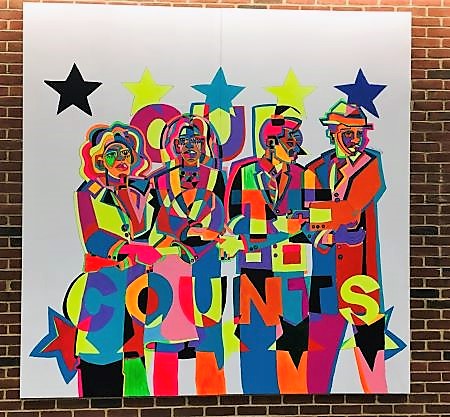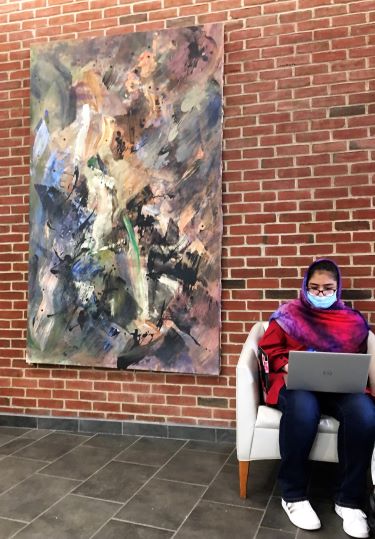
The right to vote re-emerged in 2021 as a topic of public discourse and the University of Maryland Eastern Shore has weighed in with an artistic flourish.
The first floor lobby of Hazel Hall is now the home of social justice message art that was part of a presidential election year exhibit at the Banneker-Douglass Museum in Annapolis, Maryland’s museum on Black history and culture.
The 2020 Black Vote Mural Project featured 15 works, one of which is now part of UMES’ permanent art collection: “Our Vote Counts” by James Stephen Terrell. His use of fluorescent colors makes the mural difficult to miss when entering the building.
“The message of the mural shows the viewers that African Americans and those of African descent coming together to vote,” Terrell said. “Black men and black women are a united front. United we stand hand in hand.”
The museum organized the exhibit to celebrate the 100th anniversary of the 19th Amendment granting women the right to vote and the 150th anniversary of the 15th Amendment extending “the right … to vote shall not be denied or abridged by the United States or by any state on account of race, color, or previous condition of servitude.”
When the 2020 exhibit closed, the museum and the Maryland Commission on African American History and Culture shifted to the project’s second: donating the murals to organizations across the state that prioritize Black art and history as agents of change.

Susan Holt, UMES’ Mosely Gallery director, signaled counterpart Schillica Howard, the Banneker-Douglass Museum’s curator of collections & exhibits, that the university would welcome an addition to its art collection.
“We were thrilled to be selected and, as one of the first organizations, we were able to pick our favorite piece,” Holt said. “The painting is an expressive abstraction with bright colors and a positive message. What a wonderful addition to our campus.”
Simultaneously, Dr. Marshall F. Stevenson Jr., UMES’ dean of the School of Education, Social Sciences and the Arts, heard about distribution of the murals through his work as a member of the Maryland Lynching Truth and Reconciliation Commission. He endorsed acquisition of the Terrell piece and said he would have liked to have accepted additional murals, but the museum wanted to spread the message statewide.
Terrell’s acrylic-on-wood piece is so large – 8-feet by 8-feet – that it was painted on two panels, which provided a challenge for UMES physical plant workers, who hung it Nov. 1.
Terrell studied art at Howard University and the Parson School of Art and Design, and currently teaches art. He also holds a degree in theology and ministry. His parents are the Rev. James E. Terrell, pastor of historic Second Baptist Church of Washington D.C., and Mary A. Terrell, a retired (D.C.) Superior Court associate judge.
Stevenson also arranged earlier this year for a restored 1953 painting depicting an injured Korean War soldier by late faculty member Jimmie Mosely to be hung in Hazel Hall as well.

